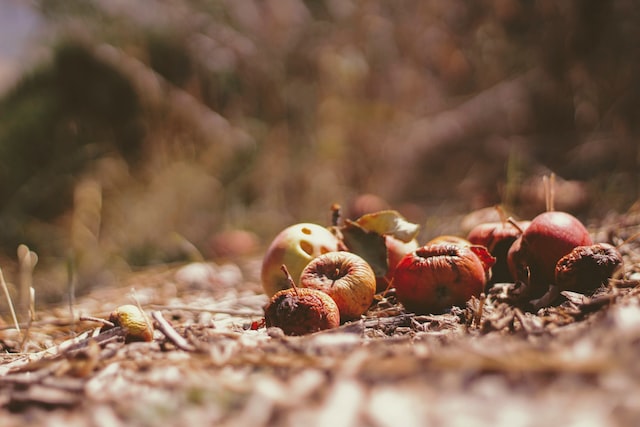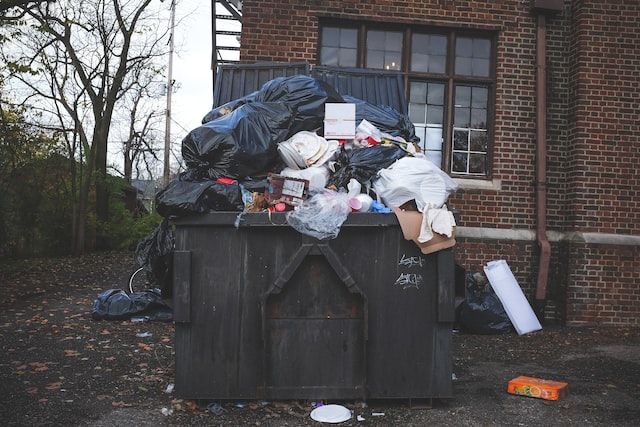Biodegradable waste is any organic matter that can be broken down by microorganisms into simple, natural substances, such as water, carbon dioxide, and methane. Non-biodegradable waste is any material that cannot be broken down by natural processes, and can persist in the environment for a long time, such as plastics, metals, and glass.
What is biodegradable waste?
(Photo by Joshua Hoehne on Unsplash )

Biodegradable waste is waste that can be broken down by biological means, such as through composting. Nonbiodegradable waste is waste that cannot be broken down by biological means, and must instead be disposed of in a landfill.
The vast majority of municipal solid waste (MSW) is biodegradable. Paper, food scraps, and yard trimmings make up the largest portion of MSW, and all of these materials are biodegradable. In fact, more than 60 percent of MSW is composed of paper and organic matter, both of which can be easily broken down by microbes.
While most MSW is biodegradable, there are some types of waste that are not. plastics, for example, are not biodegradable. Neither are glass or metal cans. These materials must be recycled or disposed of in a landfill.
It’s important to keep in mind that just because something is biodegradable doesn’t mean it should be thrown away. The best way to reduce the amount of waste sent to landfills is to recycle or compost as much as possible.
What is non-biodegradable waste?
(Photo by Kenny Eliason on Unsplash )

Non-biodegradable waste is any type of waste that does not decompose naturally. This means it cannot be broken down by bacteria or other living organisms. Non-biodegradable waste includes materials like plastic, metal, and glass. While biodegradable waste will eventually decompose and return to the earth, non-biodegradable waste will not. This can create problems for the environment because it means that this type of waste will build up over time.
Biodegradable Vs. Non-biodegradable waste – Key differences
Biodegradable waste is any organic material that can be broken down by microorganisms into simpler, natural substances, while non-biodegradable waste is any material that cannot be broken down by natural processes, and can persist in the environment for a long time. The main difference between the two is that biodegradable waste can be recycled back into the environment through natural processes, while non-biodegradable waste accumulates in the environment and can have harmful effects on ecosystems and human health.
Here are some key differences between biodegradable and non-biodegradable waste:
Definition: Biodegradable waste is any organic material that can be decomposed by natural processes, such as microorganisms, into simpler, natural substances. Non-biodegradable waste is any material that cannot be broken down by natural processes and remains in the environment for a long time.
Time taken to decompose: Biodegradable waste can decompose quickly, usually within a few months to a few years, depending on the type of material and environmental conditions. Non-biodegradable waste can take hundreds or thousands of years to decompose, and some materials, such as plastic, may never decompose.
Recycling: Biodegradable waste can be easily recycled back into the environment through natural processes, such as composting, which can create nutrient-rich soil. Non-biodegradable waste cannot be recycled in the same way, and often ends up in landfills or oceans, where it can harm wildlife and ecosystems.
Environmental impact: Biodegradable waste has a lower environmental impact compared to non-biodegradable waste, as it does not accumulate in the environment and can be safely recycled. Non-biodegradable waste can have a significant impact on the environment, as it can release toxic chemicals, pollute waterways, and harm wildlife.
Sources: Biodegradable waste comes from natural sources, such as plants, animals, and food, while non-biodegradable waste comes from human-made sources, such as plastics, metals, and synthetic materials.
The main differences between biodegradable and non-biodegradable waste are the time taken to decompose, the ability to recycle, the environmental impact, and the sources of the waste. Biodegradable waste is more environmentally friendly and can be easily recycled, while non-biodegradable waste has a greater impact on the environment and cannot be easily recycled.
What is the difference between biodegradable and non-biodegradable pollutants?
When it comes to pollutants, there are two main types: biodegradable and non-biodegradable. Biodegradable pollutants are those that can be broken down by natural processes. This includes things like food waste and paper. Non-biodegradable pollutants, on the other hand, are not able to be broken down by natural processes. This includes things like plastic and metal.
The main difference between these two types of pollutants is their ability to be broken down. Biodegradable pollutants will eventually decompose, while non-biodegradable pollutants will not. This means that biodegradable pollutants are less harmful to the environment since they will eventually be broken down and returned to the earth. Non-biodegradable pollutants, on the other hand, can stay in the environment for centuries, causing pollution and harming wildlife.
Benefits of recycling biodegradable
Biodegradable waste takes up valuable space in landfills and can release methane gas as it decomposes, which is a greenhouse gas.
Another benefit of recycling biodegradable waste is that it can be used as compost. Compost is a great way to fertilize gardens and lawns without using harmful chemicals. It also helps to reduce water usage since compost helps the soil hold onto moisture better.
And finally, recycling biodegradable waste gives us a renewable resource that can be used over and over again. Recycling helps to close the loop on the materials we use and keeps them in use for longer, which is better for the environment overall.
Benefits of recycling non-biodegradable waste
For one, it reduces the amount of waste that ends up in landfills. Non-biodegradable waste can take centuries to break down, so recycling it helps to keep landfill spaces clear. It also reduces the need for new materials to be manufactured, which can save energy and resources.
Recycling also helps to reduce pollution. Manufacturing new products from scratch releases harmful chemicals and pollutants into the environment. However, recycling existing materials cuts down on these emissions.
Finally, recycling non-biodegradable waste can create jobs. The process of sorting, collecting, and processing recyclables requires manpower. This creates employment opportunities in the recycling industry, which can help boost local economies.
What are examples for non-biodegradable products?
Non-biodegradable products are those that cannot be broken down by natural processes. This means they will remain in the environment indefinitely, unless they are recycled or disposed of properly. Some examples of non-biodegradable products include:
- Plastics (including all single use plastics such as straws, grocery bags, water bottles, etc.)
- Glass
- Styrofoam
- Aluminum cans
- Leather goods
- Certain types of electronics
What are examples for biodegradable products?
There are many materials that can be classified as biodegradable. Food scraps, paper products, and yard waste are all examples of biodegradable materials. When these materials decompose, they provide nutrients for plants and animals and help to improve the quality of the soil. Nonbiodegradable materials, such as plastics and metals, do not decompose and therefore remain in the environment indefinitely.
How to dispose of biodegradable waste?
Assuming you’re talking about organic waste like food scraps, there are many ways to dispose of biodegradable waste. One is to compost it. This means collecting your food waste in a bin and allowing it to decompose naturally, which can take months. Once it’s fully decomposed, you can use it as nutrient-rich fertilizer for your plants.
Another way to dispose of biodegradable waste is through anaerobic digestion. This is a process where microorganisms break down the organic matter in the absence of oxygen, and it results in the production of methane gas. The methane gas can then be used as a renewable energy source.
Finally, you can also just throw your biodegradable waste in the trash. It will eventually decompose in the landfill, but this isn’t the most environmentally friendly option.
How to dispose of non-biodegradable waste?
The easiest way to dispose of non-biodegradable waste is to throw it in the trash. However, some items cannot be disposed of in this way and must be recycled or reused.
Non-biodegradable waste includes items made from plastic, metal, glass, or paper. These materials do not break down naturally and can take centuries to decompose. This means that they can clog up landfill sites and pollute the environment if not disposed of properly.
The best way to recycle non-biodegradable waste is to take it to a local recycling center. Here, the materials will be sorted and sent to facilities where they can be made into new products.
If you have items that cannot be recycled, you may be able to donate them to charity shops or reuse them yourself. For example, old clothes can be cut up and used as cleaning rags, while glass bottles can be turned into vases or plant pots.
Featured Image by – Nareeta Martin on Unsplash








